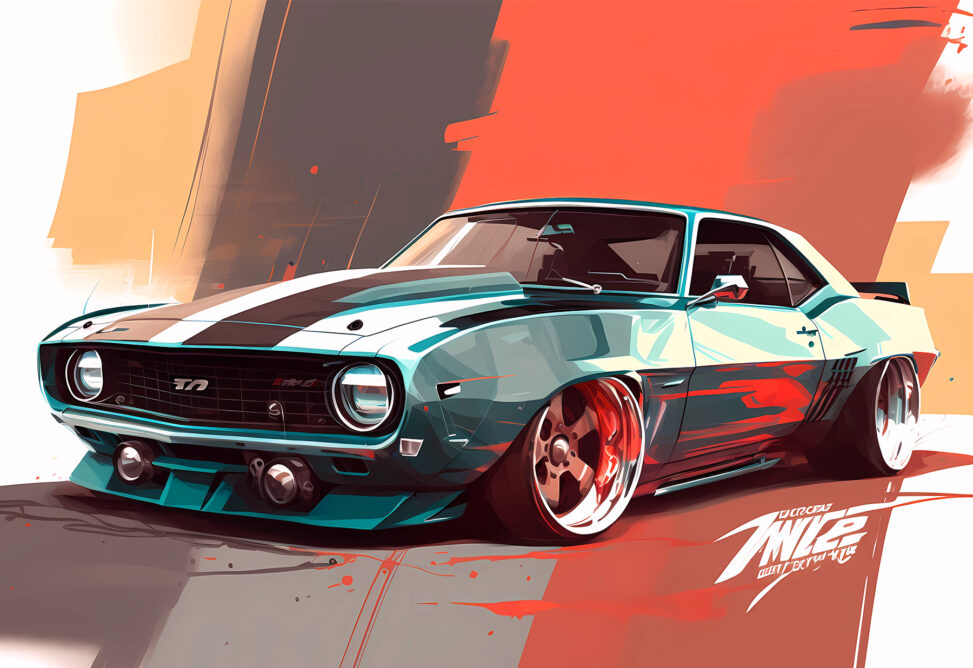The Chevrolet Camaro (First Gen): A Deep Dive into the 1968-69 Model Years
The Chevrolet Camaro is emblematic of American muscle car culture. With its debut in 1967, Chevrolet aimed to compete with the wildly popular Ford Mustang. The Camaro did not just compete; it carved a significant niche in American automotive history. Within the pantheon of classic muscle cars, the first-generation Chevrolet Camaro stands tall, and the 1968-69 models are often celebrated as the pinnacle of its early design and performance.

BUY THIS CHEVROLET CAMARO POSTER ON ETSY HERE
Evolution from 1967
While the 1967 model laid the foundation, Chevrolet introduced a few changes in the 1968 iteration. The vent windows were eliminated, and the side-marker lights were introduced in response to new safety regulations. Chevrolet also introduced the Astro Ventilation system, which removed the need for vent windows entirely.
1968: Subtle Refinements with a Raw Edge
In 1968, the Camaro underwent subtle refinements, which, while not always immediately noticeable, contributed to its overall appeal. The front and rear received a more pointed look, and the grille was redesigned with a bolder, more aggressive stance. The taillights were also updated, replacing the earlier rectangular design with a rounder shape.
Performance-wise, the 1968 model year retained much of what made the Camaro a sought-after muscle car. Engine options ranged from the 140-hp six-cylinder to the beastly 375-hp V8. The Camaro SS (Super Sport) continued its legacy from 1967, with the 396 cu in (6.5L) V8 engine roaring under the hood, a special hood with simulated vents, and distinctive SS badging.
1969: A Year of Radical Design Changes
The 1969 Chevrolet Camaro is often considered one of the most iconic muscle cars ever produced. While it retained the essence of the Camaro, the design changes were radical. The vehicle got an entirely new, more aggressive-looking sheet metal, a redesigned grille, and door panels. The ’69 model also featured more squared wheel wells and fenders, giving it a broader, more muscular stance.
The 1969 Camaro wasn’t just about looks; it was also about power. While the standard engines carried over from 1968, Chevrolet added the legendary 302 cu in (4.9L) V8 Z/28 engine. This engine was designed specifically to compete in the Trans-Am racing series.
Special Editions and Packages
The Rally Sport (RS) appearance package was available for both years, offering hidden headlights, revised taillights, and other cosmetic modifications. For those wanting the best of both worlds, Chevrolet also offered the RS/SS combo, which combined the RS’s cosmetic features with the SS’s performance upgrades.
Moreover, the Z/28 Camaro deserves special mention. Designed to race in the Trans-Am series, it featured a solid-lifter 302 V8, 4-speed transmission, power disc brakes, and two wide stripes down the hood and trunk lid.
Conclusion
The first-generation Chevrolet Camaro, specifically the 1968 and 1969 models, remains an enduring symbol of American muscle car prowess. Combining sleek designs with raw power, these vehicles capture a unique period in automotive history. Their continued popularity, both among collectors and enthusiasts, is a testament to their timeless appeal. Whether on the open road or at a car show, the Camaro’s presence is always felt, a true embodiment of American automotive legend.
